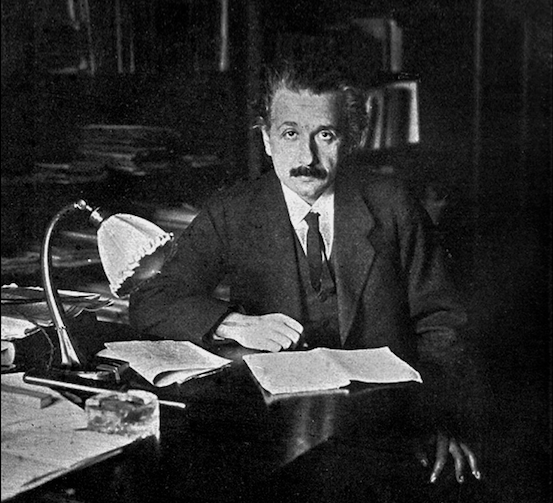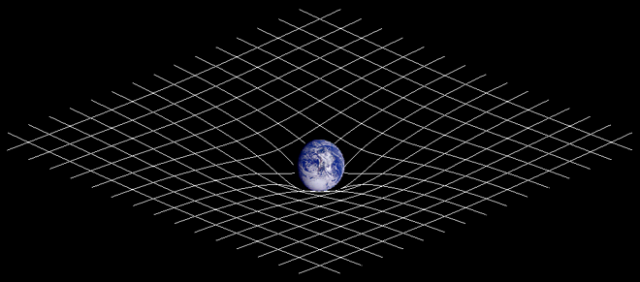
It stands among the most famous theories ever created, but the general theory of relativity did not spring into being with a single, astonishing paper like the special theory of relativity in 1905. Instead, general relativity's birth was more chaotic, involving a handful of lectures, manuscripts, and more than one parent.
One hundred years ago this fall, that harrowing labor occupied almost an entire month in November 1915. When finished, Einstein finally delivered a theory perfectly formed, if not already mature, and trembling with potential. Today, the general theory retains its status as our modern theory of gravity, and its fundamental equations remain unchanged.
However, we've learned a great deal more about the back story and consequences of general relativity in the past century. In fact over time, this model of gravity, space, and time has come to be regarded by many who know it as perhaps the “most beautiful of all existing physical theories.” But to fully appreciate all the complexity of general relativity—in substance and creation—you need to start before the very beginning.
Everyone knows relativity
Certainly many people are familiar with the famous theory of general relativity in the sense they're familiar with any celebrity. But what makes the theory tick isn't always so well-known. Perhaps the best approach to the general theory of relativity is by way of Isaac Newton and his theory of gravity. Newton’s gravity (in concert with his laws of motion) accurately predicted the motions of the heavenly bodies for over 200 years. It was the first great unification in physics, connecting our terrestrial experience with falling apples directly to the force that binds the solar system together. Newton’s work is the beginning of modern science, and the best way to begin to understand relativity is to try to understand what Einstein found unacceptable in Newton’s model of the universe.
Newton explained that gravity is a force between any two objects, proportional to the product of their masses and inversely proportional to the square of the distance between them: a simple algebraic formula. This force was an instantaneous action at a distance with no medium nor mechanism behind it.
Einstein recognized several conceptual problems with the classical theory of gravity. His special theory of relativity implied that the cosmic speed limit, the velocity of light, applied to all influences, signals, and information and not merely physical particles. This is inherent in the symmetries of spacetime and the requirement that causes precede effects. But Newton’s model of gravity implied that its forces turned on and off instantaneously as masses appeared and disappeared; there is nothing in the classical theory that admits a finite speed of propagation for gravity, as Maxwell’s equations described the finite and definite speed of light in a vacuum.
There was also the mysterious identification of the gravitational mass with the inertial mass that appears in Newton’s law of motion. This centuries-old apparent coincidence demanded an explanation.
Einstein began his critical examination of gravity as he did with his special theory—through a thought experiment. He imagined being in a windowless box, enjoying the usual experience of gravity but otherwise completely isolated from any information from the outside. After some consideration, it is clear that there is no way he would be able to determine whether he and his box were in a gravitational field, say at the surface of the Earth or in deep space far from any source of gravity, but being uniformly accelerated, say by a rocket attached to the box’s bottom. There is no experiment, in practice or in principle, that would be able to distinguish the two situations (neglecting the small nonuniformity in the Earth’s gravity that could be measured over a finite distance and considering the point of view of a single point in space).
Applying the maxim of William James that “a difference which makes no difference is no difference at all,” Einstein elevated this observation into what he called his principle of equivalence. His insistence that a theory of gravity, and the motions it brings about, respect this principle at its core became the keystone of the general theory. The methodical working out of its consequences in mathematical form became an at times debilitating obsession over many years, culminating in the field equations of 1915 that have withstood all the challenges of the subsequent century.
One might wonder why, exactly, a theory of gravity is called a “general theory of relativity.” Well, Einstein began to use this title before the theory was complete. He envisioned it as a generalization of his special theory of relativity. The special theory relates to the motion, time, and space between frames of reference that are moving at constant velocities. It showed how to relate all constant-velocity motions to each other while respecting the universally constant speed of light, and it did so by using a particular formula to transform one frame to another. Einstein assumed that he could do the same with arbitrary reference frames that might be accelerating or rotating by applying his principle of equivalence. He ultimately learned this was not quite possible—there is no general relativity of motion between accelerating frames in the sense that Einstein found in his special theory of relativity. Nevertheless, the title stuck.
What it says (relatively mathless)
To truly dig into general relativity, as in all branches of theoretical physics, it takes math. Hardcore math. The crux of the matter is the mirroring of the structure of reality in mathematical structures. And in this light, talking about a physical theory without its equations is rather like talking about music—worthwhile in some ways, but everyone can acknowledge that something is missing.
To simplify, Einstein’s theory of gravity is often introduced by saying that it describes the “curvature” of spacetime. This is evocative and certainly not wrong, but the description sometimes misleads. The gravitational equations relate mass and energy to the “metric tensor,” which is the mathematical object that describes this curvature. The metric tensor tells us how to measure distance at different points in space in different directions; it’s like a bunch of rulers that stretch and shrink as we move around.
In the normal “flat” spacetime of Euclidean geometry, these rulers are the same everywhere: the Pythagorean theorem is always true, and the ratio of the circumference to the diameter of a circle is always π. The equations of general relativity relate this metric tensor to the distribution of matter and energy in space. A massive object actually changes the rulers in its neighborhood (including the ruler that measures time, which becomes blended with the spatial dimensions to form a unified “spacetime”). The figure here is an aid to the imagination, showing how such a curved 4d spacetime in the vicinity of a planet might be represented with a 2d projection of a 3d surface.

The planets and other masses (and massless photons, as well), rather than responding instantaneously to gravitational “forces,” as in Newton’s theory, follow geodesics, or shortest paths, through this curved spacetime. It is through this mechanism that the mystery of the identity of inertial and gravitational masses is resolved.
Here lies the crux of the theory’s beauty. No longer is spacetime a blank canvas upon which the force vectors of gravity are drawn by a mysterious hand. Now the mass and energy in the universe create the malleable canvas of spacetime themselves, and to be in changing motion in this spacetime is the natural state (just as to be in rest, or uniform motion, was in the Newtonian universe). There is no longer a force of gravity, just spacetime and mass-energy.
As things move around due to the metric tensor; this alters the distribution of mass in the universe. This in turn changes the metric tensor, which determines how things move. This inseparability between motion and the nature of spacetime that determines it is the cause of the nonlinearity, which makes it so difficult to find exact (and, for that matter, numerical) solutions to the equations. Any physics student can use Newtonian physics to calculate the orbit of the Earth around the Sun, but similar problems in general relativity are research projects. (One class of solutions are the “singularities,” or solutions with infinite densities, that are called black holes.)
This situation resembles a computationally difficult area of classical physics. Fluid dynamics is intractable because of a nonlinearity that has a similar origin: as parcels of fluid move in response to the pressure field generated by the fluid medium, that motion changes the pressure field, which in turn changes the motion, etc. Just as in general relativity, exact solutions of the Navier-Stokes equations for fluid dynamics are hard to come by, and their calculation by computer is nontrivial. As you might imagine, the equations of relativistic fluid dynamics are fairly insane.
In attempting to give concrete form to the principle of equivalence, Einstein was understandably and immediately bedeviled by the complex mathematical language that these new physical ideas seemed to demand. Like most physicists then and now, he was very familiar with multivariable calculus and differential equations as well as more elementary subjects such as Euclidean geometry. But now he found that his ideas had taken him to a place where his mathematical language was not rich enough—fortunately, he had friends who could help.
reader comments
154